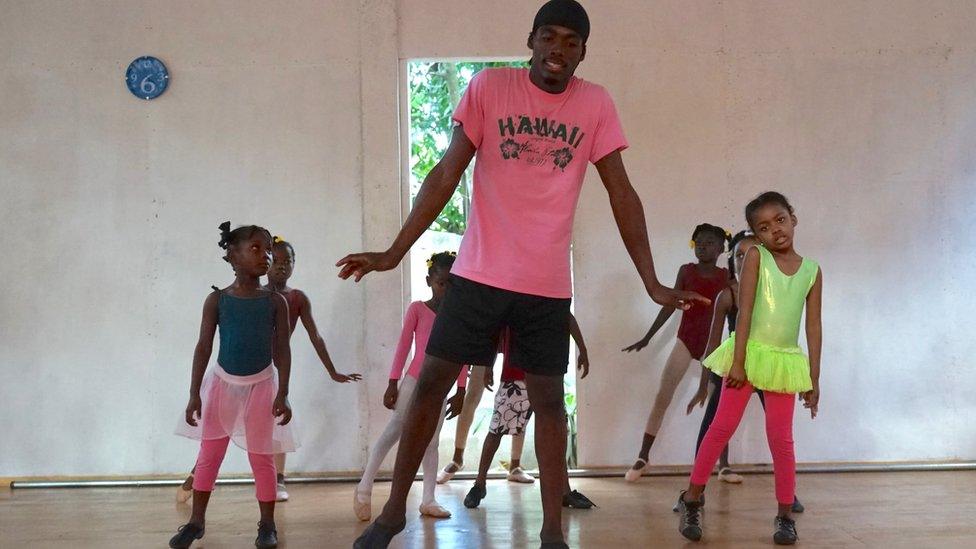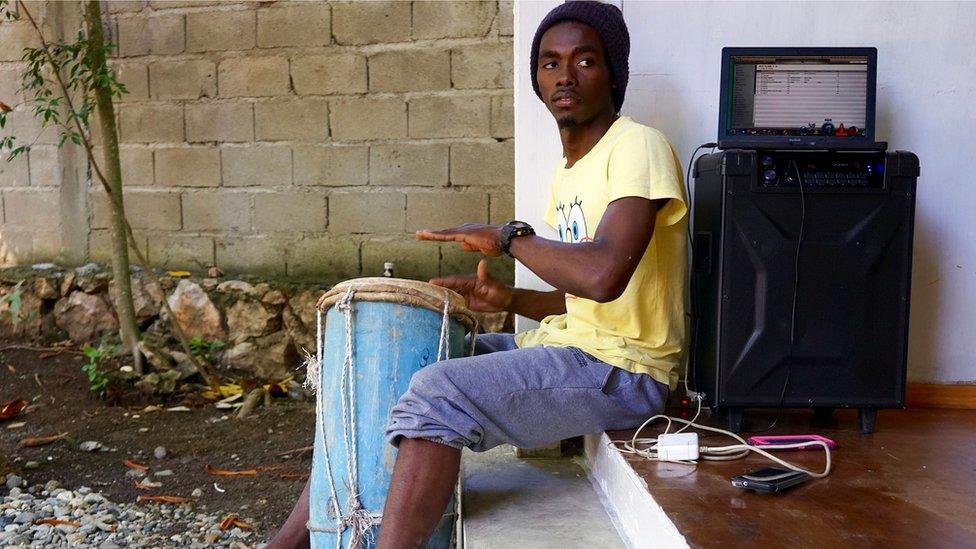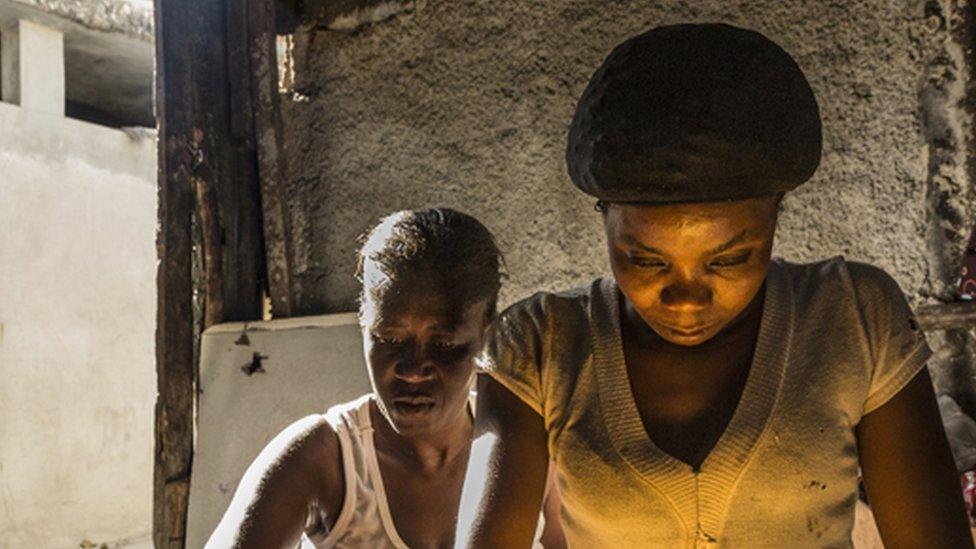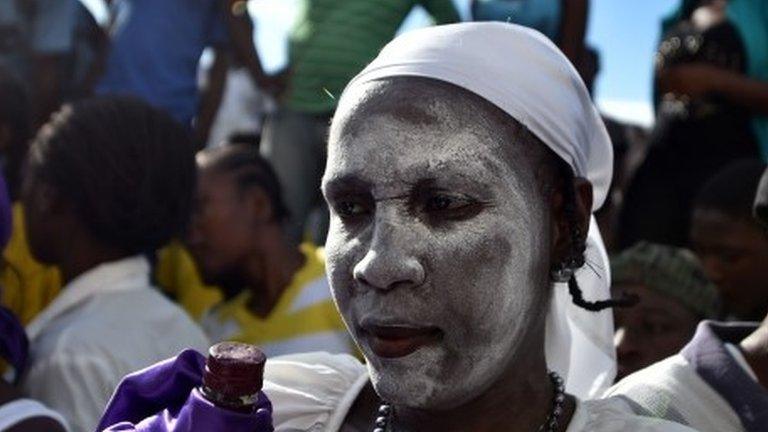The Haiti school saving children's lives through dance
- Published

Spirits are high as the young dancers mimic the moves of their lithe-limbed teacher. At this dance school with a difference, shaded by towering mango trees and tucked away from the frenzy of Cap-Haitien in northern Haiti, children are learning the steps for a forthcoming performance of the Lion King.
The high concrete surrounds and bolted metal gates are a grim reminder of the perils which lurk outside in the overcrowded city. But within these walls only kinship and ambition abound.
An oasis for the disadvantaged and the displaced, Dance to Save Lives (DTSL) was set up in 2012, external with the aim of giving needy children a skill, along with a sense of purpose and, in some cases, a roof.
With 60% of the population living on around $2 (£1.56) a day, Haiti is the poorest nation in the Americas, a plight exacerbated by high inflation and endemic corruption.
Over the past seven years, the school's founder Dieufel Lamisere has worked with scores of promising youngsters from across the country, including some uprooted by the 2010 earthquake and others controversially deported from neighbouring Dominican Republic.
In addition to dance lessons and the associated clothes and shoes, the donation-dependent project also pays for the children to attend school.

Like those he helps, Mr Lamisere is no stranger to adversity
"I was born loving dance," Mr Lamisere told the BBC. "But I was stigmatised because many people in our culture think boys shouldn't dance. My mother would tell me dancing was for gay people and that I'd disgraced the family."
It was during eight years living in the US that Mr Lamisere, now 42, launched the Haitian Dance Company, incorporating both contemporary and traditional styles which proved popular with international audiences. In 2008 he moved back home to share what he had learned with his compatriots.
But upon arrival in the holiday hotspot of Jacmel, he was shocked by the number of kids roaming the streets alone and often, he says, falling prey to sex tourists. "I decided I needed to do something to keep these girls and boys busy," he said.
"That's when the idea for Dance to Save Lives came to me. I started making flyers for free classes. The first priority is to save lives through education. The second is to give kids from poor neighbourhoods more opportunities."

The dance school also offers private lessons to local families
Themes from Africa, where most Haitian people's ancestors came from, are embedded in modern culture across the Americas, and Haiti is no exception.
"We brought our dancing with us from Africa and it's important to keep it going," Mr Lamisere said. "Our culture is everything we are; the way we eat, speak, dress."
One enduring feature of Haitians' African roots is manifested in the syncretic and often misinterpreted religion of voodoo, characterised by a belief in multiple spirits and ceremonies incorporating dance and song.
Ibo is a dance that represents freedom in tribute to the country's status as the world's first black republic, independent since 1804. Its movements emulate breaking out of the chains of slavery.

The students, aged five to 11 years old, are preparing for a performance of the Lion King
The vibrant traits, exhilarating drums and costumes appeal to the school's students who are currently aged five to 11 and attend daily sessions.
The project also provides an avenue for taking Haiti's rich traditions beyond its shores; DTSL is collaborating with dance groups in the US, Brazil, Turks & Caicos and Dominican Republic and Mr Lamisere hopes to expand this further.
After almost three decades in the industry, Mr Lamisere has a knack for spotting potential.
"Most of the kids I am working with now are from the poorer suburbs of Cap-Haitien but have a special talent," he said. "The school gives them the opportunity to do what they love. And what is better for them, to be out in the city stealing, killing or prostituting, or being here learning something?"
Keeping children off the streets is one thing, but the ultimate goal is to train the youngsters to become professional performers, choreographers and tutors. Mr Lamisere's most cherished protégé is 22-year-old James Joseph, who joined the group at the age of 16 and has since been adopted by Mr Lamisere as his son.

James Joseph, now a teacher at DTSL, joined when he was 16 years old
"Dancing was something new for me then. I have made a lot of progress and hope to make a future from it," said Mr Joseph, who is now working as a DTSL teacher himself.
"I feel good helping other children in the same way Dieufel helped me. It's great watching them progress, especially when you've spent time teaching them steps and then you see them do it exactly the way you taught them," he said.
Asked what he thinks life might have been like for him without DTSL, Mr Joseph hesitated, then he said, "I would not be doing what I'm doing now; maybe I would be in jail or worse."
For Mr Lamisere, the school also offers the children a sense of home. "I do my best to make sure the kids' time with us is comfortable, enjoyable and happy," he said. "Some come because they love to dance and want to one day become a professional. Some are just looking for love."
- Published18 February 2019

- Published17 June 2018

- Published2 November 2015

- Published7 October 2016
